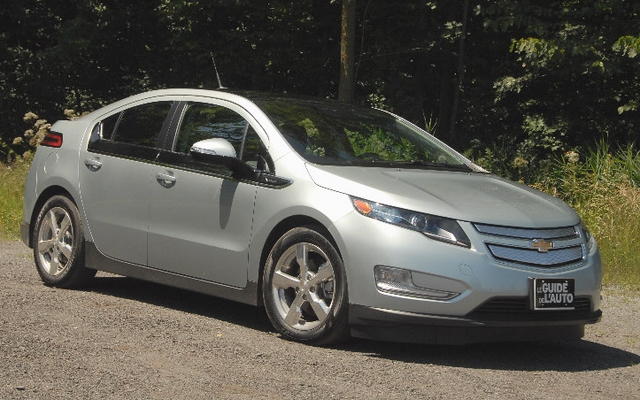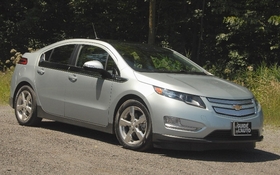2012 Chevrolet Volt – The ideal solution?

| Strong points |
|
|---|---|
| Weak points |
|
Seldom has a car garnered so much attention. Since its unveiling at the 2007 Detroit Auto Show, this car has been the subject countless reviews, both good and bad. At first, people said "GM will never go into production with a car like this. It’s just a flash in the pan." Then, when the definitive model rolled out onto the American market last fall, a lot of people called the Volt out for false representation. They accused it of being a plug-in hybrid rather than a true electric car with an extended range. Others called it an imposter because they believed its combustion engine delivered power to the front wheels – which, incidentally, is not true.
The American press loves to slam anything coming from Chevrolet. Thus, this lukewarm reception was to be expected. But that didn’t stop the Volt from being named North American Car of the Year. The 2011 model was also Motor Trend’s Car of the Year – a title it was eligible for because the Volt had been on sale in the U.S. since November 2010.
- Also: New Details Emerge Regarding the Next Chevrolet Volt
- Also: Chevrolet's Volt And Bolt Are In Toronto
Now it’s Canada’s turn to welcome the Volt, which will be available in dealerships as of this fall. I attended the Canadian premiere, where my first – and positive – impressions from last year’s global launch were confirmed.
Tech talk
Now, I don’t want to bore you by going too deep into the technical details of this car. I’ll just summarize the basics. The first thing you should know is that there are three main categories of cars that run on electric power. There are the 100% all-electrics that draw power from a battery and usually have a 100-250 km range. Once the battery runs out of juice, the car is out of luck.
Then there are hybrid vehicles. These have batteries, an electric engine and a combustion engine. Hybrids can only cover short distances in electric mode. After that, the combustion and electric engines interact while you drive. And finally, there are plug-in hybrids, in which the car’s battery can be charged at a charging station or at a 120-volt domestic outlet. These vehicles can typically cover 30-40 km in electric mode, after which point the combustion and electric engines share the work.
And finally, there’s the Volt. It’s a 100% electric car that can cover 50-65 km emissions-free, depending on the battery’s charge level. Once the battery is depleted, its small 1.4-litre combustion engine kicks, bringing the range up to approximately 500 km. The power produced by the combustion engine doesn’t go to the wheels; rather it acts as a generator to maintain a minimum level of battery charge, thus ensuring there is power for the main electric engine. Under no circumstances does the gas engine directly power the wheels. Plus, in some cases, it will automatically link to the two electric engines for maximum power and improved performance.
Essentially, that’s all you need to know to asset the pros and cons of each system. What’s great about the Volt is that you can cover a decent distance in all-electric mode. If we’re to believe the stats from automakers, your average Canadian driver uses his car to travel 60 km per day. Theoretically, that means that most Volt owners could stick with purely electric driving most days of the week, as long as the battery got recharged at night. Then, when you want to take your car a little further, the combustion engine boosts your range significantly. Having personally tried all three types of electric/hybrid cars, I was both impressed and reassured by the Volt.
When dreams come true
The first time I saw the Volt concept car was at the 2007 Detroit Auto Show. Its avant-garde appearance and rare elegance really caught my eye. Sadly, it was impossible to recreate that shape in a production model – especially considering that its attractive shape was an aerodynamic nightmare. The vehicle’s designers therefore came out with a new body, this one being pretty, but much less spectacular.
That said, today’s Volt is still an elegant vehicle. It is well-balanced and features reduced overhang. The windows are generous and there’s no problem whatsoever with visibility. The beltline is lower than the front and trunk hoods. This approach has been used at Chevrolet before, but typically with less success. The Volt is a hatchback, which is not the most popular configuration in the U.S. But there has been an upswing in hatchback popularity over the last few months, so hopefully the Volt will be able to cash in on that trend.
Anyone who has driven the Volt, or even just carefully inspected it, is sure to love the dashboard. It manages to be modern, serious and elegant all at once. Some people have their reservations about the touch controls on the vertical console, but this technology is gaining ground these days and I see nothing wrong with it. Plus, the controls are very intuitive. To the left of the steering wheel, the dashboard features a small button to switch the information display, shown in the middle of the indicator dial module. It’s simple and easy to understand. The same goes for the display. For example, you’ll see a green ball between two vertical lines. When this ball hovers in the centre of the two lines, it means your driving style efficient and ecological. The higher the ball climbs, the more energy you’re using. A low position indicates that you’re recovering energy while braking. And like all cars in this category, you can switch the climate control to "eco" or "regular".
The front seats are wide and very comfortable. The same can be said for the two back seats (this car seats four people only), though leg room is a bit tight in back.
Mechanics and drive
Before taking this special Chevy for a spin, you should know that it shares the Cruze’s platform and its naturally aspirated 1.4-litre combustion engine. This engine is linked to two electric motors that power the vehicle’s front wheels. The lithium-ion battery was developed with Korean company LG Chem and is produced in a new plant in Michigan. This T-shaped battery pack consists of 288 cells whose temperature is stabilized with cooling or heating cells. It’s also worth noting that the battery is never depleted beyond 35% and never charged beyond 85%, as a means of prolonging its useful life. Power is delivered to the wheels via a very sophisticated transmission integrating the main electric motor. This transmission changes the way it works depending on how you drive.
But enough with the technical gobbledygook! What you really need to know is that this car is pleasant to drive and its outstanding stability on corners translates into superior road handling. This comes as no surprise since the battery is positioned just off the ground, ensuring a low centre of gravity. Of course, in purely electric mode, you have to give it time to accelerate, as aggressive driving will drain your battery more quickly. If you adopt an easygoing attitude and respect the speed limit, you can definitely cover 60 km on a single charge. Past that point, the combustion engine will kick in, and yet it remains very quiet.
On the highway, when you reach about 120 km, this car is impressively stable, silent and powerful. Contrary to many other hybrids that I’ve driven in recent months, the braking is good, without the hesitation you see on other models.
Charging this car is very easy. You simply use its special extension cord to plug it into a 120-volt outlet. When I tried it, the battery was completely recharged within 10 hours. You may be interested to know that the extension cord is long enough to reach the outlets in your typical suburban home. Overall, my first hands-on experience with this car last fall was entirely positive. It was also voted North American Car of the Year. And I wouldn’t be at all surprised if the Volt earns more awards on the Canadian market!











